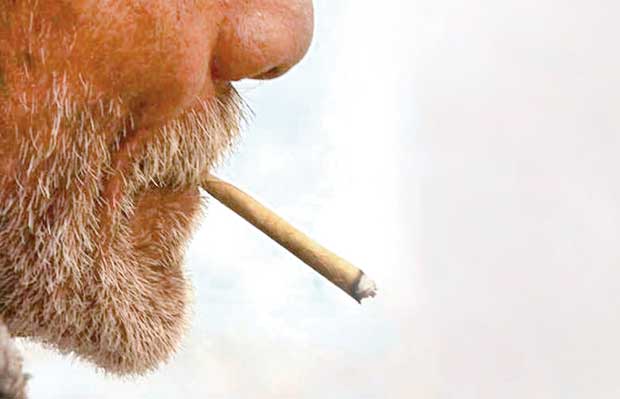Reply To:
Name - Reply Comment
Last Updated : 2024-04-24 13:34:00

Flakes of tobacco rolled in Indian Tendu leaf stands a stick named beedi which contributes largely to an epidemic that claims six million lives each year around the world.
According to statistics of the World Health Organization (WHO) in 2015, out of these six million people, more than 600, 000 are non-smokers dying from passive smoking. It also predicts that, if failed to take sound action against tobacco consumption, the epidemic would kill more than eight million people every year by 2030. More than 80% of these preventable deaths will be among people living in low-and middle-income countries.
While the global scenario remains at this, the impact tobacco consumption has had on the health of people in Sri Lanka is no less with Health Ministry statistics indicating that smoking leads to the death of sixty Sri Lankans on a daily basis. In other words, some 21,000 die annually with government  spending between Rs. 10 to 15 million to treat a single cancer patient.
spending between Rs. 10 to 15 million to treat a single cancer patient.
With common acceptance that smoking is injurious to health and causing cancer; authorities are tightening their grip on mainstream cigarettes in the market, they have paid less or no attention at all in regulating alternative tobacco products. For instance, the beedi industry in the country remains under regulated despite having an average revenue of Rs 4.6 billion annually without having to pay real taxes whereas the cigarette industry generates approximately Rs. 90 billion annually of which the lion’s share goes to the government as taxes.
The major tax charge on beedi is customs duty on tendu leaves in which they are wrapped. With the import tax on tendu leaves being as low as Rs. 250 per kg, the industry paid only around Rs. 370 million in tax to the government in 2015.
According to the Alcohol and Drug Information Centre (ADIC), beedi is the cheapest smoking tobacco product in the country with the average price of a stick being Rs. 2.50 (minimum Rs. 2 to maximum Rs. 3.50). Beedi smoking is prevalent among low-income groups in the country and mostly among persons above 40 years (74%).
Most beedi smokers have a minimal or no educational background at all, and are mainly engaged in daily wage labour. Most common reasons for beedi usage were found to be “support for late night jobs”, “to get rid of the tiredness” and “to pass time” which were linked to their occupations. This implies that beedi smokers are also trapped in the common myths attached to tobacco smoking.
According to spot surveys conducted by ADIC, the highest number of beedi smokers is from the Moneragala District. Ironically, Moneragala is also identified as the poorest District in the country, thus proving it is the low income earners who are most vulnerable to health risks involving the consumption of tobacco.
Last year the WHO made the theme of the ‘World No Tobacco Day’ which falls on May 31 every year as “Stop illicit trade of tobacco products” where they emphasized the need to stop illegal trading of tobacco products and the necessity to regulate tobacco products.
While the beedi industry in Sri Lanka is not marked as illicit, it indeed is under regulated while enjoying a freedom of entertaining minimal taxation and being lesser insistent on displaying pictorial warnings as against the country’s main cigarette manufacturer. This may have resulted in people in the country having smoked over three billion beedi sticks in 2014 against 3.5 billion cigarettes smoked. According to reports by Sri Lanka Customs, beedi volumes have tripled over the last seven years, increasing from 1.1 billion sticks in 2007 to three billion sticks in 2014. Interestingly, the data also depicts a 13% decline in the cigarette volumes during the same period of time.
Statistics show that beedi volumes have increased by 180%, which have contributed to a 25% increase in the overall tobacco sector in the country. This is despite legal cigarette volumes showing a 13% reduction. As of now, beedi holds 42% of the total tobacco market share in Sri Lanka, a certain flourishing industry that the government should consider imposing a higher taxation.
As for the pictorial warnings, the excuse that the beedi industry gives is that it comes in round bundles and not in packages thus having a practical issue of displaying pictorial warnings.
Nevertheless, In India, the beedi industry is bigger and faces strict regulation by government authorities has made it compulsory to display 85% pictorial warnings on either side of the packet.
As the high cost of cigarette results in younger generation and low income category opting to products like beedi, several countries like the USA treat beedi the same way it does to conventional or legal cigarette. The government’s efforts to eradicate the menace of cigarettes in the past few years are commendable, and we see the results. But the question remains why beedi is left out of the limelight and remains unchecked through regulation or taxation. The aggressive battle against tobacco must continue and it must be fought in a way to include even the thus far ignored beedi. It is high time that the authorities identify and plug the loopholes that exist in the system that allows beedi to thrive despite all the efforts taken to wipe out smoking from Sri Lanka for good.

Add comment
Comments will be edited (grammar, spelling and slang) and authorized at the discretion of Daily Mirror online. The website also has the right not to publish selected comments.
Reply To:
Name - Reply Comment
US authorities are currently reviewing the manifest of every cargo aboard MV
On March 26, a couple arriving from Thailand was arrested with 88 live animal
According to villagers from Naula-Moragolla out of 105 families 80 can afford
Is the situation in Sri Lanka so grim that locals harbour hope that they coul